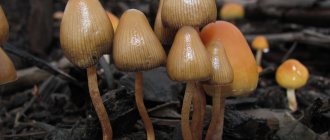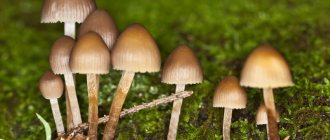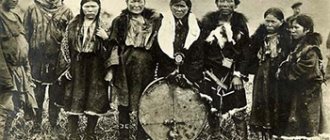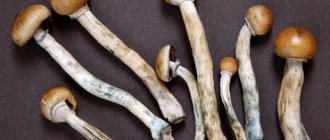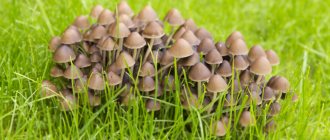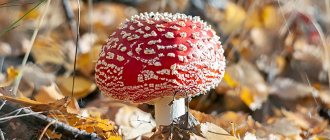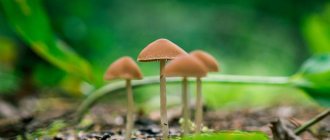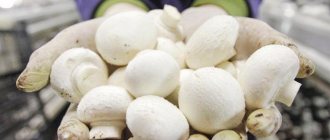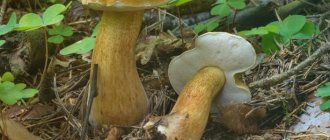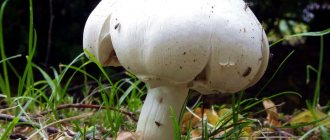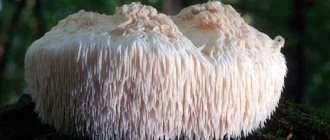It is well known that in addition to edible mushrooms, in our latitudes there are specimens that are not suitable for food or even poisonous. Hallucinogenic mushrooms stand apart from this list. Being conditionally edible, they have no culinary value, but when consumed they can have a severe impact on the human consciousness. One of these species is Sulfur Head.
Description of the mushroom
Sulfur head is a hallucinogenic mushroom of the Strophariaceae family, genus Psilocybe. Latin name: Psilocybe mairei, Hypholoma cyanescens, Geophila cyanescens.
The mushroom is miniature in size, the diameter of the cap does not exceed 25 mm. The shape is directly related to age - in very young specimens it is cone-shaped, and over time it becomes bell-like. In mature mushrooms, it is flat or curved upward.
If there has been no rain for a long time, the cap is yellow in color; as air humidity increases, it acquires a pleasant chocolate hue. If you press on the surface or cause any other damage, a blue spot will form in this place.
The hat has a rather dense structure, becoming brittle only in old age. If the weather is dry, it has an unremarkable surface. As soon as the air humidity increases, a sticky coating similar to mucus forms on it.
The hymenophore, or in other words, the lower part of the cap, is decorated with reddish-brown, loosely fused plates. As they age, their color changes to purple-brown. The hymenophore of mature specimens is covered with black-purple spots.
The stem of the mushroom is brittle, pliable, with small delicate fibers. It reaches a length of 20–100 mm, its diameter is approximately 3–6 mm. It has a uniformly thickened shape with an increased diameter in the part close to the ground. Typically slightly curved. The stem often contains remnants of the shell skin. The color is uneven - the upper part is almost snow-white, the lower part is a rich yellow-orange color.
When cut, the flesh of the mushroom has a creamy-yellow tint and emits the smell of withered grass and mold.
Hallucinogenic mushrooms, including sulfur head, have been known to mankind since ancient times. In the 60-70s, their widespread use spread to America and then to Europe.
"Body of God"
Since ancient times, people, trying to understand the mysteries of nature and higher powers, have used psilocybin mushrooms as a guide to other worlds. The most ancient evidence of their use by people was found in Africa and dates back to the eighth-fourth millennium BC. Drinks made from hallucinogenic mushrooms were used in ancient India back in the pre-Aryan era.
In Ancient Greece, during the “great Eleusinia” - the celebration of the victory of life over death, hallucinogens obtained from ergot were used during the mysterious “Eleusinian mysteries”.
In pre-Columbian America, in the Aztec and Mayan cultures, psilocybes had enormous ritual significance. The Aztecs called Psilocybe Mexicana “teonanacatl” - “body of god”, and only those especially initiated were allowed to eat them. Special places of worship with sculptures of a magic mushroom with a human face were discovered in Guatemala. Some Central American tribes still use magic mushrooms in their cult rituals.
The legendary fearlessness of the Scandinavian Vikings is partly explained by their considerable addiction to eating fly agarics. These same passions are still characteristic of the shamans of the northern peoples of Chukotka, Taimyr and Kamchatka. They know many ways to prepare them, including eating reindeer meat that has been previously fed with fly agarics. To increase endurance, shamans gave hunters young unopened fly agaric caps, peeled, since they contain the largest amount of active substances.
The first official medical report of "intoxication" with psilocybin mushrooms was published in London in 1799, when an entire family was unintentionally poisoned by them.
Edible look-alikes
Psilocybin mushrooms are quite similar to each other. Below are descriptions and photos of sulfur head lookalikes, clearly demonstrating the diversity of this group of hallucinogenic mushrooms.
Important! There are no absolutely edible analogues of sulfur head; there are only less dangerous ones, since they contain relatively small amounts of toxic substances.
Peneolus ligamentus has the typical appearance of a hallucinogenic mushroom. It is distinguished by a thin stem, the surface of which is covered with velvety pile.
Psilocybe papillary at an early age has a strong external resemblance to the chamois head. Over time, the cap of the latter flattens and bends upward, while in the papillary psilocybe it remains the same - in the form of a bell.
Law is law
Before reading about the long and interesting joint history of these mushrooms and humanity, you should know that PSILOCYBIN MUSHROOMS ARE PROHIBITED by the legislation of the Russian Federation (Article 231 of the Criminal Code of the Russian Federation on the illegal cultivation of prohibited plants containing narcotic substances, Articles 10.5 (and 10.5.1) Code of Administrative Offenses of the Russian Federation, Decree of the Government of the Russian Federation of November 27, 2010 No. 934).
Any type of use of psilocybin-containing mushrooms can entail not only mental difficulties, but also serious problems with the law. Therefore, use the information obtained here wisely and with caution.
Dangerous twins
| Psilocybe blue | While completely similar to the chamois head, it has a distinctive feature in the form of fused legs. The fungus can cause a powerful disruption in the functioning of the nervous system and affect vision and hearing. |
| Psilocybe Czech | Unlike the chamois head, it has a thin stalk. Causes powerful hallucinations. |
| Psilocybe mexicanis | Has a hallucinogenic effect and can cause severe vomiting. It differs from the chamois head in the blue color of the legs. |
Sulfur head
Ethnomycologists and psychopharmacologists have long been studying the properties of hallucinogenic mushrooms and the effect they have on the human psyche and the body as a whole. One of the objects of close study is the mushroom Sulfur head, unsuitable for consumption, but interesting from a scientific point of view of its influence on the mental state of a person.
Sulfur head
Sulfur head - lat.Hypholoma cyanescens
This mushroom is also called Psilocybe Meira.
Description
Mushroom cap
The small cap of the Psilocybe Mair mushroom reaches 2.5-5 cm. Young mushrooms have cone-shaped hats, more mature specimens acquire bell-shaped “headdresses”, then flat with notches or low tubercles and strongly raised edges.
The hats are covered with a tough, smooth skin, sticky and yellow in dry weather, and damp and chestnut-colored during the rains.
Old hats lose their strength and become brittle. Their amber flesh takes on a bluish tint after damage.
The bottom of the hat is loosely formed by weakly growing plates of a cinnamon, later purple-brown hue, with light edges. The plates of ripe mushrooms are covered with black and purple spots remaining from spores that have matured and left the mushroom.
Sulfur head reproduces by dark purple-brown elongated spores.
Stipe
Psilocybe Meira grows a high cylindrical leg 0.3-0.6 cm thick and 2.5-10 cm long, slightly widening towards the base. It can be flat along its entire length or slightly curved at the bottom or in the middle. Silky fibers remain on it.
The upper part is white, turning downwards into a pale yellow and amber tone. The site of damage to the leg becomes bluish.
Sulfur head - lat.Hypholoma cyanescens
Places of growth
The sulfur head prefers dead tree trunks and branches, wood debris lying in the damp grass of coniferous, deciduous and mixed forests. It is found in forests with oak, pine and spruce trees growing in European, Russian, Ukrainian, Belarusian and North African soil.
On wood, the mushroom bears fruit in families, in grass - singly. The fruiting period, depending on the climate, is from August to early January.
Edibility
Psilocybe Meira is not consumed as food due to its psychoactive components. Eating it leads to strong reactions from the nervous system, temporarily completely changing the human psyche, turning a person into a schizophrenic.
15 minutes after eating mushrooms, or a little later if they are not eaten on an empty stomach, people become extremely surprised by the rapidly changing situation.
Later they begin to become delusional and think that time has stopped or, on the contrary, has accelerated, and the world around them has become too small or incredibly huge, very bright and noisy. It seems to a person that he is separated from the body and lost in an alien space. Some behave detachedly, others begin to go on a rampage and become dangerous to others.
Sulfur head does not cause physical addiction, as in the case of drug addiction or alcoholism, only mental, no less negative: long-term use of the mushroom “kills” the kidneys and heart.
Similar species and differences from Psilocybe Mayra
Psilocybe Mayra in appearance and effect on the human psyche resembles the following inedible tribesmen:
- Psilocybe Czech . A hallucinogenic variety with a smaller cap (it is about a centimeter smaller) and a cream or pale ocher color. In contrast to the blue flesh of Sulfur Head, the flesh of Psilocybe Bohemian turns blue. Its stem is cream-colored, and fruiting occurs only in the autumn months.
- Psilocybe turns blue . Another doppelgänger with hallucinogenic qualities. It differs from Psilocybe Meira in having a small cap and a short white leg (its length is no more than 50 mm), which turns blue as the mushroom matures. In addition, its legs often grow together, and fruiting occurs in the fall.
Chemical composition
The main active ingredients are alkaloids:
- Psilocybin is a dimethyl psychedelic of the tryptamine family.
- Psilocin is a derivative of psilocybin, formed during processing in the intestines. It is this that causes the effect of altered consciousness.
- Beocystine is a monomethyl indole alkaloid.
- Norbaeocystin is a demythylated derivative of baeocystin.
Important! Sulfur head is considered a conditionally edible mushroom, but only after prolonged exposure to high temperatures, as a result of which the toxic components in the composition are destroyed. But even in this case, a slight clouding of consciousness is possible.
Spreading
Sulfur head is widespread throughout the forest belt of the temperate zone of Europe, and is also found in North Africa. It grows either on dead wood of deciduous trees, less often - of coniferous trees, or on soil rich in woody substrate, among grass. It is found both singly and in small groups, with single mushrooms growing on the ground, and “families” forming on wood. The fruiting period is from July until the first frost.
Psilocybe Maira.
Effect of action (trip), symptoms of poisoning and first aid
Sulfur head is a mushroom with high hallucinogenic activity. Its use has a profound effect on human consciousness. The effects are similar to the consequences of using the drug LSD. This condition is called a trip.
In terms of external manifestations, the behavior of a person who consumes mushrooms is similar to that of a person suffering from schizophrenia.
The first signs of poisoning appear after 15–20 minutes, but taking it on a full stomach can delay the onset of the trip. At first the person gets lost in space, then delirium sets in and he feels dizzy.
One gets the feeling that time stops moving or, on the contrary, rushes forward at an unrealistic pace, and space contracts or expands.
Light and color stimuli are perceived in a modified form. The sensitivity of the organs of hearing and vision is greatly enhanced. The mind seems to be outside the body.
Experiences caused by damage to consciousness can be both positive and negative and affect a person’s mood and general condition.
First aid consists only of preventing a person under the influence of brimstone from committing dangerous actions. After some time, the effect will go away on its own.
Sulfur head
Sulfur head is an inedible hallucinogenic mushroom .
What are hallucinogenic mushrooms? What do hallucinogenic mushrooms look like?
The science of psychopharmacology and ethnomycology studies the properties of hallucinogenic mushrooms and their effect on the human body. All mushrooms are divided into several groups according to their suitability for food: edible, conditionally edible, inedible and poisonous.
Edible include mushrooms that can be safely eaten even raw.
Mushrooms that contain toxic substances that become harmless when cooked or cooked are considered conditionally edible However, there is still a risk, so it is better not to collect such mushrooms without the appropriate knowledge and experience. But it is worth noting that you can also be poisoned by mushrooms, which initially did not pose any danger, did not contain toxic substances and were edible, for example, porcini mushrooms or the same honey mushrooms. If they lie in a warm place for a long time, the proteins contained in them will begin to decompose, forming toxins. You should also not collect overripe, slightly spoiled or worm-eaten mushrooms, despite the myth that mushrooms that have been eaten by insects can be safely eaten. After all, many toxic substances that are deadly to humans will cause absolutely no harm to insects.
Inedible mushrooms are mushrooms that are unsuitable for food due to their taste. However, they do not contain toxins or other hazardous substances.
Poisonous mushrooms are mushrooms that contain toxic substances and can lead to severe food poisoning and even death.
Sulfur head mushroom - description and photo
The inedible mushrooms include the sulfur head mushroom. It is included in this group because of the psilocybin and psilocin it contains. To date, these mushrooms are poorly studied. The size of the cap of the sulfur head is from 25 to 50 millimeters in diameter. The leg grows up to 100 millimeters in height and 6 millimeters in diameter. The shape of the mushroom is very variable. Young representatives are distinguished by a cone-shaped cap, which over time takes on the shape of a bell, and by the end of maturation it becomes flat, slightly curved towards the top and with a small tubercle in the center. The stem of the sulfur head is always slightly curved, almost uniform in thickness, only at the base of the mushroom are thickenings caused by the accumulation of peel residues. The color of the cap ranges from yellow to brown, depending on the environment. The stem of the mushroom is white, becoming more amber towards the base. If you press on the mushroom or injure it, then in this place the surface will acquire a bluish tint. In dry weather, the mushrooms are lighter in color, but in damp weather they darken, becoming chestnut. The structure of the mushroom changes accordingly. Most often, these mushrooms have a strong, smooth stem, slightly sticky, but in dry weather or in old age they become brittle.
The spore-bearing layer is brown in color with black-brown spots due to ripe spores. The location of the spores is loose. Hallucinogenic sulfur head mushrooms grow mainly in damp areas, singly or in small groups; they prefer trunks of fallen trees or rotten stumps, thickets of grass, bushes or heaps of damp fallen leaves. The sulfur head mushroom is found until about the beginning of December, starting in August and ending with the first cold weather.
Useful facts
The group of psilocybin mushrooms, which includes sulfur head, have a number of characteristic features by which they can be easily recognized:
- miniature hat of yellow, olive or red color;
- the upper plate grows to the leg or descends along it;
- granular spores, usually brownish-purple in color;
- cartilaginous structure of the leg.
Having knowledge of what a potentially dangerous mushroom looks like, what the mechanisms of action of toxic substances are and what consequences threaten its use, you can prevent intoxication or promptly provide first aid to the victim.
Heroes of Hallucinogenic Science
The great Swiss chemist Albert Hofmann, who gave the world lysergic acid diethylamide, first isolated psilocybin in the laboratory in 1957 from the Mexican Psilocybe, and soon psilocybin was already artificially synthesized.
Gordon Wasson was the first to actively promote the idea of hallucinogenic psilocybin “trips” in the West when, in 1957, he published his photo essay in Time Magazine entitled “The Search for the Magic Mushroom,” where he described in detail his experiments on them under the guidance of the Mazatec Indians.
In 1962, this article inspired Timothy Leary and Richard Alpert, scientists from Harvard University, to create the Harvard Psilocybin Project, which became one of the defining moments of the “acid sixties” era.
During the psychedelic cultural revolution of the second half of the sixties, a bag of dried psilocybes became as common a sign of the times as the music of Pink Floyd.
In the very early seventies, psilocybin was included in the UN Convention on Psychotropic Substances as a Schedule I drug in the United States, making it illegal for all purposes. But psilocybin mushrooms themselves were not prohibited there, which still allows countries that have signed this convention to regulate issues of attitude towards them and their use at their own discretion.
